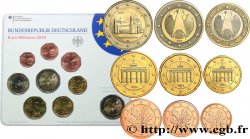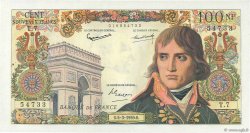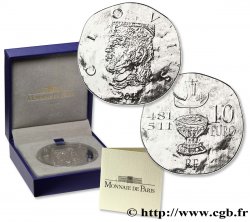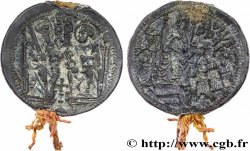fme_851418 - GERMANIA Médaille, L’âge du fer
non disponibile.
Articolo venduto sul nostro negozio (2024)
Prezzo : 35.00 €
Articolo venduto sul nostro negozio (2024)
Prezzo : 35.00 €
Tipo : Médaille, L’âge du fer
Data: 1916
Metallo : ferro
Diametro : 40,5 mm
Asse di coniazione : 12 h.
Peso : 19,65 g.
Orlo : lisse
Commenti sullo stato di conservazione:
Patine sombre hétérogène, des taches d’oxydation dans les champs. Présence de quelques coups et rayures. Petite usure
Diritto
Titolatura diritto : IN EISERNER ZEIT // 1916.
Descrittivo diritto : Allégorie féminine casquée tenant des chaînes.
Rovescio
Titolatura rovescio : GOLD / GABICH ZUR / WEHR EISEN / NAHM ICH ZUR / EHR.
Descrittivo rovescio : Légende en 5 lignes au dessus d’une branche de chêne. Signé : HOSACUS.
Traduzione rovescio : J’ai donné de l’or pour du fer.
Commento
Pour soutenir les guerres de libération contre Napoléon, la belle-sœur du roi prussien Friedrich Wilhelm III. (1770 - 1840) Marianne de Prusse (1785 - 1846) lance en mars 1813 le fameux "Appel des princesses royales aux femmes de l'Etat prussien" et fonde l'"Association des femmes de la Patrie". Dans l'appel, elle a appelé les femmes prussiennes à échanger leurs bijoux en or contre une broche, une médaille ou une bague en fer avec l'inscription "J'AI DONNÉ DE L'OR POUR LE FER". Cette demande a été satisfaite dans de nombreux cas. Il a été répété pendant la Première Guerre mondiale, mais s'est bientôt adressé non seulement aux femmes, mais aussi aux clubs, aux communautés ecclésiales et aux agences gouvernementales.
Dès 1916, la Reichsbank décerne une médaille à ceux qui donnent des bijoux ou échangent de l'or contre du papier-monnaie (qui se déprécie rapidement). Les médailles conçues par Hermann Hosaeus (1875-1958) ont été émises dans de nombreuses variantes et de très grandes éditions.
To support the wars of liberation against Napoleon, the sister-in-law of Prussian King Friedrich Wilhelm III (1770–1840), Marianne of Prussia (1785–1846), launched the famous \\\"Appeal of the Royal Princesses to the Women of the Prussian State\\\" in March 1813 and founded the \\\"Association of Women of the Fatherland.\\\" In the appeal, she called on Prussian women to exchange their gold jewelry for a brooch, medal, or iron ring bearing the inscription \\\"I GAVE GOLD FOR IRON.\\\" This request was granted in many cases. It was repeated during the First World War, but soon became addressed not only to women, but also to clubs, church communities, and government agencies. As early as 1916, the Reichsbank awarded a medal to those who donated jewelry or exchanged gold for paper money (which quickly depreciated). The medals designed by Hermann Hosaeus (1875-1958) were issued in many variations and very large editions
Dès 1916, la Reichsbank décerne une médaille à ceux qui donnent des bijoux ou échangent de l'or contre du papier-monnaie (qui se déprécie rapidement). Les médailles conçues par Hermann Hosaeus (1875-1958) ont été émises dans de nombreuses variantes et de très grandes éditions.
To support the wars of liberation against Napoleon, the sister-in-law of Prussian King Friedrich Wilhelm III (1770–1840), Marianne of Prussia (1785–1846), launched the famous \\\"Appeal of the Royal Princesses to the Women of the Prussian State\\\" in March 1813 and founded the \\\"Association of Women of the Fatherland.\\\" In the appeal, she called on Prussian women to exchange their gold jewelry for a brooch, medal, or iron ring bearing the inscription \\\"I GAVE GOLD FOR IRON.\\\" This request was granted in many cases. It was repeated during the First World War, but soon became addressed not only to women, but also to clubs, church communities, and government agencies. As early as 1916, the Reichsbank awarded a medal to those who donated jewelry or exchanged gold for paper money (which quickly depreciated). The medals designed by Hermann Hosaeus (1875-1958) were issued in many variations and very large editions








 Segnalare un errore
Segnalare un errore Stampate la pagina
Stampate la pagina Condividi mia selezione
Condividi mia selezione Fai una domanda
Fai una domanda Consegnare / vendere
Consegnare / vendere
 Descrittivo
Descrittivo















